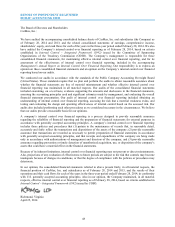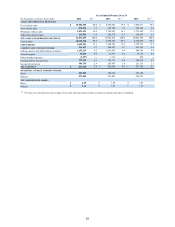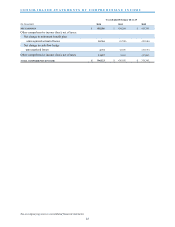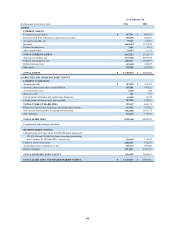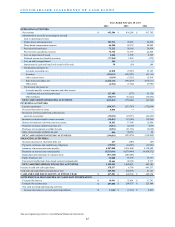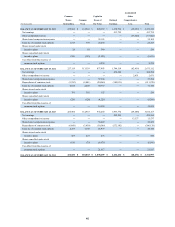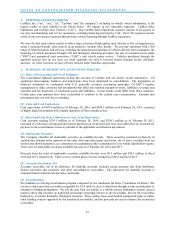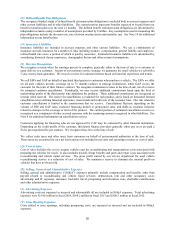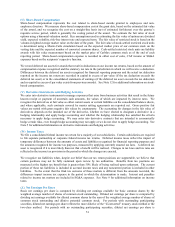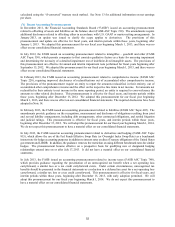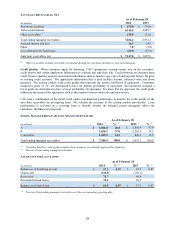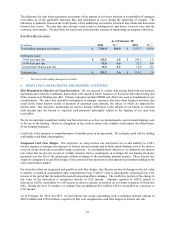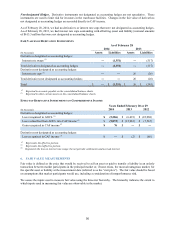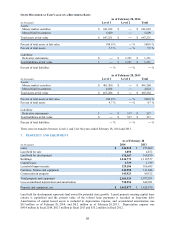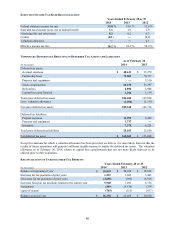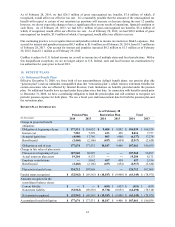CarMax 2014 Annual Report Download - page 55
Download and view the complete annual report
Please find page 55 of the 2014 CarMax annual report below. You can navigate through the pages in the report by either clicking on the pages listed below, or by using the keyword search tool below to find specific information within the annual report.51
(U) Share-Based Compensation
Share-based compensation represents the cost related to share-based awards granted to employees and non-
employee directors. We measure share-based compensation cost at the grant date, based on the estimated fair value
of the award, and we recognize the cost on a straight-line basis (net of estimated forfeitures) over the grantee’s
requisite service period, which is generally the vesting period of the award. We estimate the fair value of stock
options using a binomial valuation model. Key assumptions used in estimating the fair value of options are dividend
yield, expected volatility, risk-free interest rate and expected term. The fair value of restricted stock is based on the
volume-weighted average market value on the date of the grant. The fair value of stock-settled restricted stock units
is determined using a Monte-Carlo simulation based on the expected market price of our common stock on the
vesting date and the expected number of converted common shares. Cash-settled restricted stock units are liability
awards with fair value measurement based on the market price of CarMax common stock as of the end of each
reporting period. Share-based compensation expense is recorded in either cost of sales, CAF income or SG&A
expenses based on the recipients’ respective function.
We record deferred tax assets for awards that result in deductions on our income tax returns, based on the amount of
compensation expense recognized and the statutory tax rate in the jurisdiction in which we will receive a deduction.
Differences between the deferred tax assets recognized for financial reporting purposes and the actual tax deduction
reported on the income tax return are recorded in capital in excess of par value (if the tax deduction exceeds the
deferred tax asset) or in the consolidated statements of earnings (if the deferred tax asset exceeds the tax deduction
and no capital in excess of par value exists from previous awards). See Note 12 for additional information on stock-
based compensation.
(V) Derivative Instruments and Hedging Activities
We enter into derivative instruments to manage exposures that arise from business activities that result in the future
known receipt or payment of uncertain cash amounts, the values of which are impacted by interest rates. We
recognize the derivatives at fair value as either current assets or current liabilities on the consolidated balance sheets,
and where applicable, such contracts covered by master netting agreements are reported net. Gross positive fair
values are netted with gross negative fair values by counterparty. The accounting for changes in the fair value of
derivatives depends on the intended use of the derivative, whether we have elected to designate a derivative in a
hedging relationship and apply hedge accounting and whether the hedging relationship has satisfied the criteria
necessary to apply hedge accounting. We may enter into derivative contracts that are intended to economically
hedge certain risks, even though hedge accounting may not apply or we do not elect to apply hedge accounting. See
Note 5 for additional information on derivative instruments and hedging activities.
(W) Income Taxes
We file a consolidated federal income tax return for a majority of our subsidiaries. Certain subsidiaries are required
to file separate partnership or corporate federal income tax returns. Deferred income taxes reflect the impact of
temporary differences between the amounts of assets and liabilities recognized for financial reporting purposes and
the amounts recognized for income tax purposes, measured by applying currently enacted tax laws. A deferred tax
asset is recognized if it is more likely than not that a benefit will be realized. Changes in tax laws and tax rates are
reflected in the income tax provision in the period in which the changes are enacted.
We recognize tax liabilities when, despite our belief that our tax return positions are supportable, we believe that
certain positions may not be fully sustained upon review by tax authorities. Benefits from tax positions are
measured at the highest tax benefit that is greater than 50% likely of being realized upon settlement. The current
portion of these tax liabilities is included in accrued income taxes and any noncurrent portion is included in other
liabilities. To the extent that the final tax outcome of these matters is different from the amounts recorded, the
differences impact income tax expense in the period in which the determination is made. Interest and penalties
related to income tax matters are included in SG&A expenses. See Note 9 for additional information on income
taxes.
(X) Net Earnings Per Share
Basic net earnings per share is computed by dividing net earnings available for basic common shares by the
weighted average number of shares of common stock outstanding. Diluted net earnings per share is computed by
dividing net earnings available for diluted common shares by the sum of the weighted average number of shares of
common stock outstanding and dilutive potential common stock. For periods with outstanding participating
securities, diluted net earnings per share reflects the more dilutive of the “if-converted” treasury stock method or the
two-class method. For periods with no outstanding participating securities, diluted net earnings per share is


